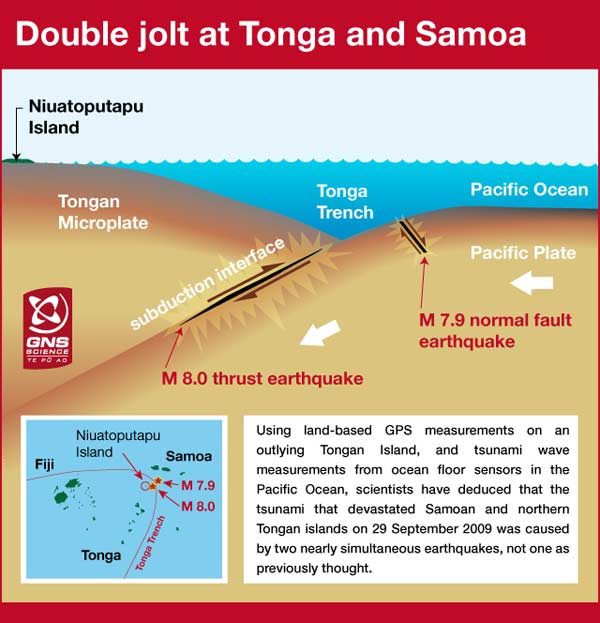
Surprise 2nd Quake Discovered Behind Deadly Tsunami

The deadly tsunami that washed over the southwest Pacific islands of Samoa and Tonga last September may have been triggered by not just one but two giant earthquakes, new research suggests.
However, which of the overlapping earthquakes would have struck first, and how one would have set off the other, is still up for debate.
The finding of a second earthquake was completely unexpected.
"Here we had two events that were comparable size, yet only one made it into the catalog" of the U.S. Geological Survey, said Thorne Lay of the University of California, Santa Cruz, lead researcher on one of two newly published studies on the topic. "To think that we would miss a magnitude-8 earthquake somewhere in the world is pretty amazing."
Scientists suspect the seismic waves of one quake were buried under the signal of the other.
Global seismic recordings and Global Positioning System data from Samoa had traced the tsunami to a single, magnitude-8.1 normal-faulting earthquake in the Pacific Plate. But inconsistent information soon started flowing in from tsunami sensors on the ocean floor, and then from the outlying Tongan island of Niuatoputapu. Rather than the expected shift of Niuatoputapu roughly 30 to 40 millimeters (1.2 to 1.6 inches) west after the earthquake, for example, the island's GPS log showed about a 400-millimeter (15.7-inch) shift to the east.
The only way researchers could reconcile the discrepancy was to change their story. It now appears two equally large but very different earthquakes occurred almost simultaneously: a normal quake in which the ground was pulled apart, and a megathrust quake where one plate was forced under another.
Sign up for the Live Science daily newsletter now
Get the world’s most fascinating discoveries delivered straight to your inbox.
Scientists have known earthquakes, and not just aftershocks, can travel in pairs, called earthquake doublets. "But usually the spacing between the two is much longer, like days, weeks or a few months," said John Beavan of GNS Science, in New Zealand, who was lead researcher on the other study. "This is the first time we've been able to disentangle two this close together."
Based on their GPS and tsunami data, Beavan's team thinks the megathrust quake caused stress changes in the Pacific Plate, which then incited the normal quake. However, he admits he can't be certain it didn't happen the other way around.
Meanwhile, Lay and his colleagues did their own detective work analyzing the seismic waves. While most of their conclusions match Beavan's, they are convinced the normal fault quake came first, generating the cascade of events that cost nearly 200 lives.
If the connection between the temblors is confirmed, it will be the first time such a quake pattern was detected, and it could have implications in preparing for future seismic disasters.
"When one event can trigger another event on a different fault, in a different location, and have this compounded hazard, that really raises the complexity of tsunami or earthquake forecasting," Lay said.
Regardless of who is correct about the seismic sequence, the scientists know they have uncovered something special. "These double events are extremely rare," Beavan said. "It's just a really weird and wonderful thing to have discovered."
Both studies are detailed in the Aug. 18 edition of the journal Nature.
- 7 Ways the Earth Changes in the Blink of an Eye
- Natural Disasters : Top 10 US Threats
- Images: Deadly Earthquakes
This article was provided by OurAmazingPlanet, a sister site to LiveScience.









